Alleyne and Wissa Foster Interdisciplinarity in New Biomimetics/Bioinspiration Course
“I think we’ve reached a plateau where engineering alone can’t solve any new challenges. So as engineers, we need to step outside what we know in engineering. We need to go to biology, chemistry, art, music. This was an opportunity for me to tell students, ‘You need more than what you are to make the world better.’” – Aimy Wissa
May 3, 2017
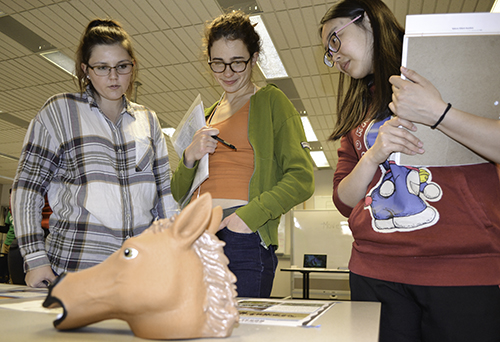
Members of an ME498/IB496 team deliberate about whether to sign up for Complex Systems: Horse Herds during the nature auction.
Folks in different disciplines, say engineering and biology, often don’t know how to talk to each other and, thus, have trouble collaborating. So Marianne Alleyne, a Research Scientist in Integrated Biology’s Entomology Department, and Aimy Wissa, an Assistant Professor in Mechanical Science and Engineering (MechSE), have teamed up to try to change that. They’ve designed a new biomimetics/bioinspiration course, ME 498/IB496, which seeks to use an advanced design experience to foster an interdisciplinary mindset among students in the course.
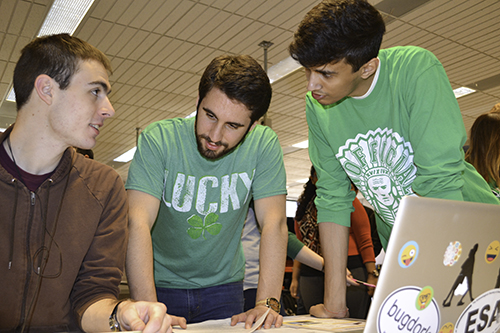
Above: During the Nature Auction, a team of students discuss which nature functions to bid on.
Below: The above team shows off its final project. During testing, weights in increasing increments were placed into the bucket which was suspended by the twine from their device.
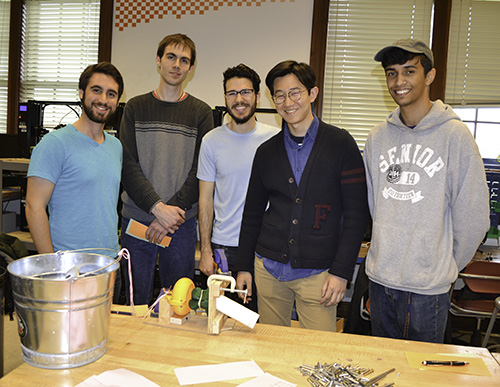
According to Wissa, interdisciplinary, not multidisciplinary collaboration, is the goal. She explains the difference. “Multidisciplinary means I do my thing, and then after that you can do yours. The product at the end is a multidisciplinary product. Interdisciplinary, to me, is that we are together during every part of the process— scientists that appreciate the value of these teams and the potential of using nature in design.”
What inspired Alleyne and Wissa to do this course? Alleyne says bioinspired design or biomimicry is “a different way of thinking, and I think there is a real possibility.”
Wissa shares their goals for the class: “We really wanted to teach a class where we can both be teaching about bioinspiration, but also have engineers and biologists in the same room,” admits Wissa. “And we won’t just teach them how to do it; they would actually do it. So they would go through the process, rather than just hear about the process.”
Wissa adds that she also hopes to foster interdisciplinary communication:
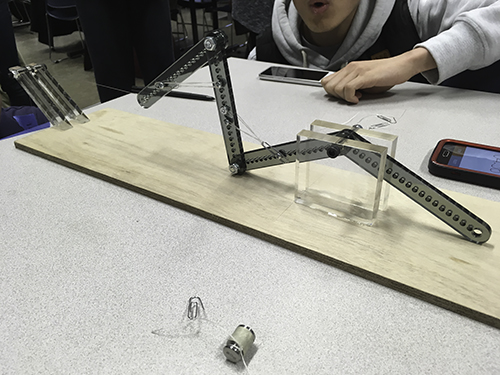
A team's mini design challenge (image courtesy of Aimy Wissa).
“I’m very passionate about this idea of nature inspiring design,” she says, “but also the biggest thing is how little engineering students communicate outside their discipline…We don’t really know how to talk to each other—biologists to engineers,” admits Wissa.
So the thirty seniors and grad students (six biologists, and 24 engineers) who signed up for the course’s maiden voyage have spent the Spring 2017 semester learning to communicate outside of their discipline. The class format was lectures on Monday and Wednesday; Fridays, they did labs, each with a different objective. For example, on Bio Day, students were exposed to insects from Entomology.
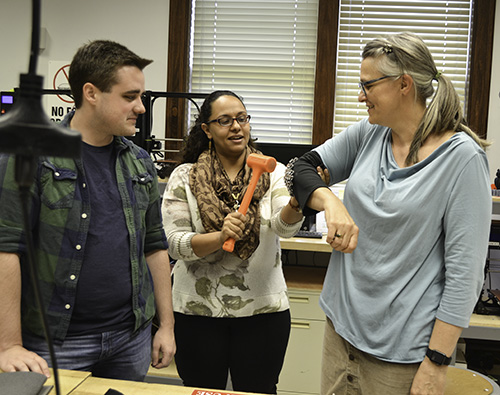
An ME498/IB496 student watches as Wissa and Alleyne desomonstrate how his team's project works.
Since interdisciplinary design is a key emphasis of the class, students formed interdisciplinary teams to work together on a couple of bioinspiration design challenges.
For example, the first week of class, teams were assigned a mini design challenge. Using fishing wire, they were to build muscles, linking something up in the same way an arm functions. Teams had just five days to do the project, so “They had to depend on each other, says Wissa. “A single member couldn’t do it in a week.”
Surprisingly, students went beyond the human arm—something more familiar to them—choosing to replicate other examples from biology, such as a frog’s leg and an alligator’s jaw.
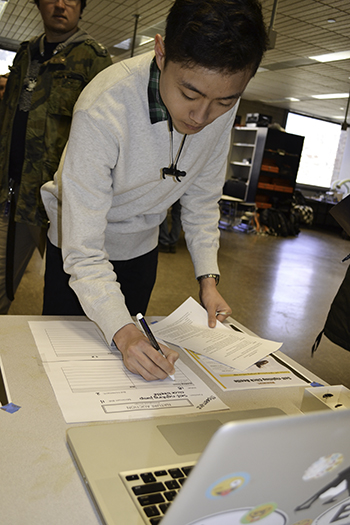
A student signs his team up for one of the natural functions students could bid on during the Nature Auction.
All lectures and activities led up to the final class project in one of the four areas the class was focusing on: movements, sensing, materials, and complex systems. Students had a budget of $150 to complete the project, and were assigned milestones—the proposal phase, design review, and final design review—to keep them on track until they had completed their project.
The biggest difference between other MechSE project/team-based design courses and theirs? Their problems were ill-defined on purpose. Wissa explains that for some classes, "They may be asked to design a robot that moves from point A to point B, So the problems are very defined. Here, they have to define the problem and the solution, and then define the process.”
Regarding problems students were to address, their instructors gave them options to start from, like, “The world needs a better water extraction process.” Wissa adds, “So we give them different approaches and let them design the solution.”
Of course, having students come up with their own problem is a lot harder than a well-defined problem; that’s why the two recruited seniors and grad students. “We wanted to get students in this class that had enough technical foundation so that they could go into the literature and find their own answers,” Wissa admits.
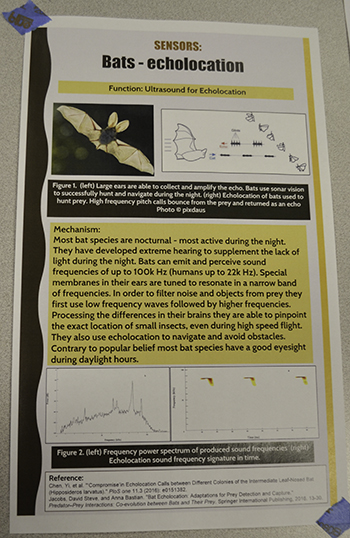
One of the functions related to sensors, bats' echolocation, students could bid on during the Nature Auction.
To help teams come up with a project, a nature auction was held on Friday, March 3rd, where students got to bid on several natural functions needed for their final project.Functions, related to the four areas the class was focusing on, included: movement (copepod: sneak attack, owl wings’ adaptive devices, corrugates on dragonfly wings), sensing (skunk cabbage, bats-echolocation, eye of dragonfly, pine cones, shark lateral line system, owl asymmetric ears), materials (hydrophobic lotus leaves, bat wing membrane, cicada wings, nacre, bone, mammalian skin), and complex systems (bees, starling flocks, horse herds, and slime mold intelligence).
“We are going to auction nature off,” says Wissa. “So we will exhibit some natural functions, and the students are going to bid on them.”
The hidden goals of the auction were to expose students to as many different functions as possible, get them to start thinking about their final projects, and to emphasize the value of the teams’ diversity. “On a very fast pace, it will encourage them to make decisions as a team, which one to buy, or bid on,” says Wissa.
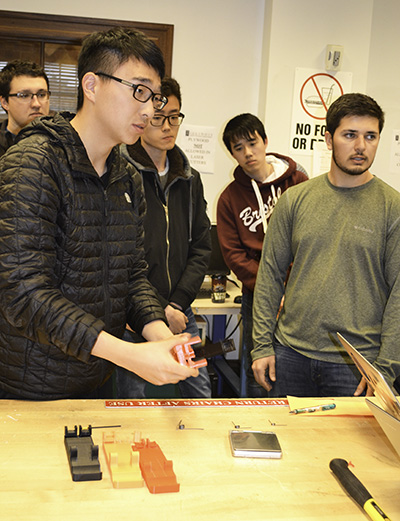
An ME498/IB496 student demonstrates how his team's prototype works at the final class session.
Alleyne reports that a team focusing on sensing, for instance, might have considered bidding on pine cones, which can sense humidity; cabbage, which can sense temperature; and sharks, which can sense vibration. “So you are thinking of a certain design that you want to create, and one of those sensors will be more valuable to you.”
Also different from other projects classes is that students were to make a prototype. Some design courses end with a conceptual design. “So a design on a report,” Wissa explains. “Here, we’re trying to push them through prototyping, and we’ll see what happens. They’re going to build…something.”
“They’re going to build something,” Alleyne reiterates, but indicates that what they want to see is students’ grasp of their design’s constraints.
“If the report says, ‘I was inspired by this, and I looked at five different biological systems, and I know my limits are based on this because of evolutionary constraints or time constraints or something,’ I’m happy,” she continues. “Just the fact that they looked into five biological systems.”
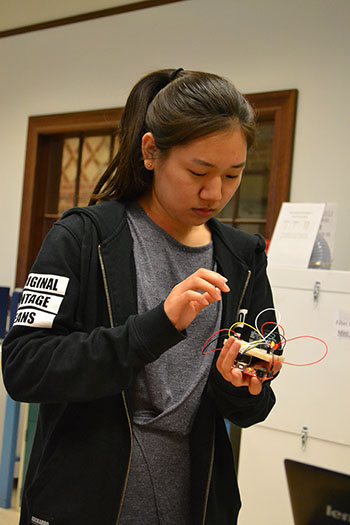
A ME498/IB496 student works on their project.
“As long as they understood what they are ignoring, and what they’re adopting, we’re cool with that,” confirms Wissa.
How difficult has it been to foster interdisciplinary collaboration between biology and engineering students? They’ve been doing it from the very beginning: “So they were forced almost on week one to work together, and to come up with something that had both biology and engineering in it,” says Alleyne.
Was there a tendency for biology students to sort of sit back when their team was addressing mechanical engineering, and, vice versa, for engineering students to do so when dealing with biology? To circumvent this, the instructors instituted class rules: “They’re absolutely NOT allowed to do that,” Alleyne insists. “And we actually forced them to deal with that by saying the person presenting the engineering portion had to be a biologist, and vice versa.”
Another incentive? Teams that had engineers report on the biology, and vice versa, got extra credit. “So we had engineers come up to tell us about different muscles, and the biologists talked about torque,” Wissa divulges.
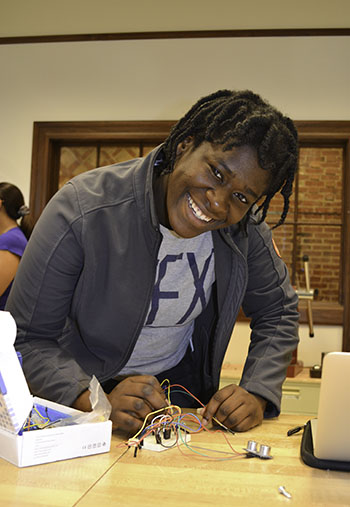
An ME498/IB496 student works on her team's project.
But it appears the students got more out of interdisciplinary collaboration than just a good grade. “I think they enjoy working together,” admits Wissa. “If I didn’t know who the biologists were or who the engineers were, I would not know from the way they interact, because the collaboration is there.”
The part that’s not there yet is an in-depth understanding on the part of, say, engineering students of how their example from nature does what it does. “They’ll say, ‘Great, I can do that. I don’t know how they do it, but I know how to create something that looks like that,’” admits Wissa.
But both agree that the students do need to know how and why what they’re trying to emulate from nature does what it does. “Right,” agrees Alleyne. “So that’s what we’re trying to get them to do. So we’ll get them there.”
Alleyne shares additional benefits for students from both disciplines: “Engineers get appreciation for the fundamentals of research, because we never know where it’s going to end up. And engineers now have a new tool in their tool box, so if they get stuck or need a new way to do something, they now have this new tool. For biologists, it gives them a reason. So they study how a fish’s jaw works, and now this gives them an application for it.”
Since one of the goals of the class was to foster communication across disciplines, Wissa and Alleyne ostensibly had it all figured out beforehand in order to collaborate on the course, correct? Not quite. Both admitted that they had encountered some engineering-vs-biology disconnects along the way, which further emphasized the need for the course.
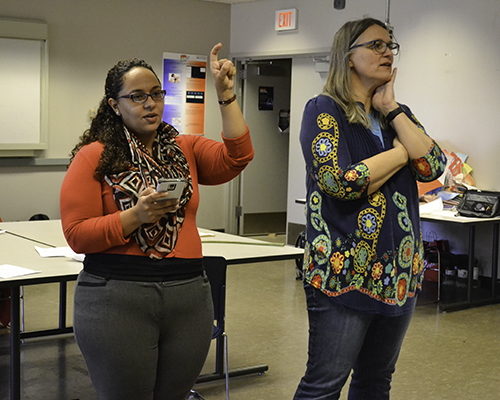
ME498/IB496 instructors Aimy Wissa and Marianne Alleyne give students instructions during the nature auction.
“So even though we’re both STEM, we don’t know how to talk to each other. So she would say something like “stress,” and I would think of a material straining, while she could mean physiological stress. So I think the problem is more exacerbated when you have students. For the last three to four years, they have been sitting in classes that only speak their language. Now we want them to get out of their comfort zone. And both on the technical communication level and on just forcing them to go read biology. Forcing the biologists to learn more about design.”
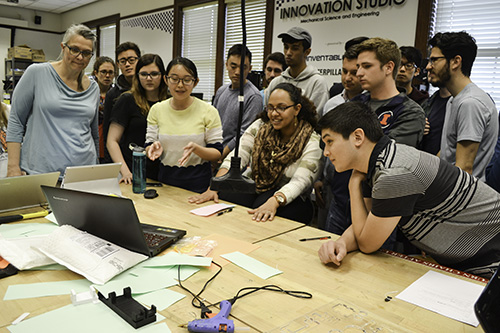
A team of students present their final project to instructors Marianne Alleyne and Aimy Wissa during the final class session.
And since learning the jargon from different disciplines is key in communicating, have the two learned each other’s jargon? “Getting better!” acknowledges Alleyne.
However, they evidently don’t always know what the other thinks, but have learned to clarify. “You know to ask, ‘What do you mean?’” Wissa explains.
According to Alleyne, they also keep each other honest. “I am kind of a stickler for the idea that it’s really based on science,” she says, “while a lot of the bioinspiration examples are more superficial or not really based on science, and I think we’re both getting to the point where we’re both holding each other accountable for that.”
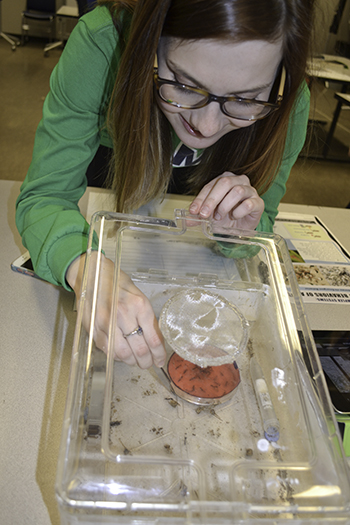
A student examines ants at the "Complex Systems: Emergent Behaviors of Ants table during the Nature Auction.
Wissa says some of Alleyne’s fastidiousness regarding authentic bioinspiration has actually rubbed off on her. “She has also converted me into a skeptical. Because what engineers are supposed to do is say, ‘Oh, this thing flies this way,’ or ‘This thing walks this way. I can make an engineering system do the same thing.’ But they don’t really dig deep into ‘How does this thing do it?’ What are the biological, chemical, or physical things that lead to this behavior?”
In addition to communication, Wissa says interdisciplinary collaboration requires empathy: “And the best way to have empathy is to work with them. And I think from a biologist’s standpoint, they almost know a different approach to problem solving that could be completely different to an engineer’s.”
Regarding the bioinspiration component, Alleyne indicates that “Nature is best at the really small stuff. Even your big birds are ultimately feathers and how the feathers are made. It does the small stuff really well.” She shares that for a long time, scientists weren’t able to see that, but with the creation of microscopes, are now able to model it, start fabricating it. “This is a really exciting time.”
She also clarifies that bioinspiration not a new way of thinking. “DaVinci looked at birds to see how to make man fly, so it’s not a new way of thinking, but the power of nature is in the small stuff. Like an ant can build an amazing nest, but we see them as just dumb ants. But somehow they have creatve intelligence by cooperating with each other in a certain way. That’s why I think now is an exciting time, and why it’s so popular.”
Both admit that bioinspiration also has its limits: “And vice versa is that nature doesn’t always have the best solution,” says Alleyne. “Because nature is very constrained by ‘What is the environment like that made an animal or plant the way it is?’ On the other hand, it’s been 3.7 billion years; structures can’t just switch in certain trajectories, while engineers can.”
Wissa adds another caveat in regards to bioinspiration: “We always say that biology or nature is a great initial condition; you should never assume it’s an optimal solution. That’s another thing we’re trying to hammer through their heads.”
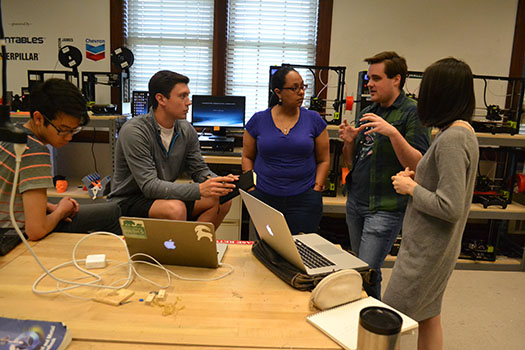
A ME498/IB496 team explains their project to instructor Aimy Wissa.
Both instructors consider the course to be a design project in itself and are excited about how it’s going to ameliorate down the road:
“I’m really excited for the potential of what it will be with time and iterations,” says Wissa. “This course within itself is a design project, and design projects don’t have an end until you understand better.”
Alleyne agrees. “We’re learning from the process of how students deal with these activities and these assignments. We want to know the process that they are going through, so that in the future, we know how to teach it better.”
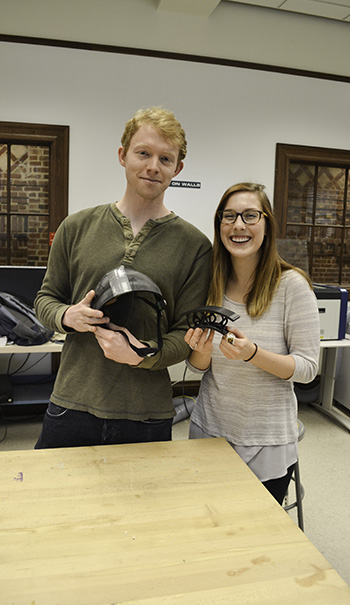
Two students exhibit their team's prototype.
Their goal is to develop better-equipped, more well-rounded students: “Just also to give students the confidence,” says Alleyne. “The students here at the University of Illinois in engineering have already accomplished a lot in a certain manner. This is different though, and I think it’s a very valuable skill to have—to communicate and collaborate and create something.”
Story and photographs by Elizabeth Innes, Communications Specialist, I-STEM Education Initiative.
For I-STEM articles about other innovative undergraduate courses, see:
- “Double Bind” Study Examines Obstacles Women of Color Face in Engineering
- Engineering for Social Justice Scholars Program Helps Students Rethink Engineering's Role in Society
- New ENG 198 Course Teaches Freshmen the Engineering Process, Teamwork, While Addressing Personal Mobility
More: Engineering, Undergraduate Education Reform, 2017
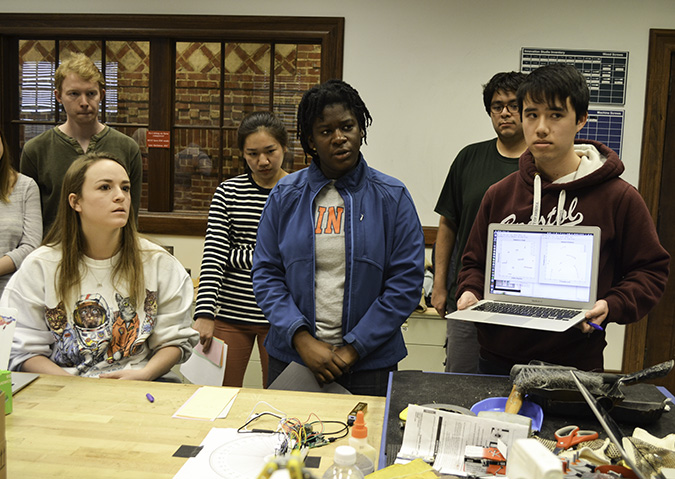
A team presents on its final project about biosensing.
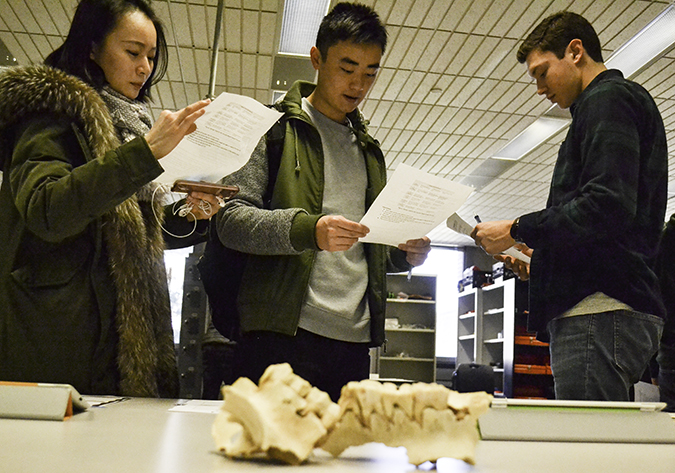
A team deliberates on whether to bid on the Materials: Bones natural function.













.jpg)
















